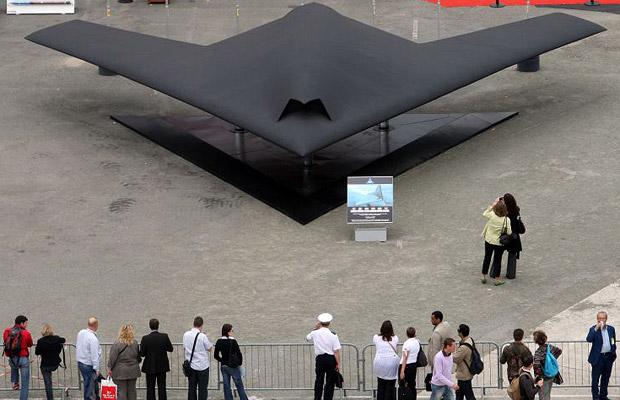It looks like you're using an Ad Blocker.
Please white-list or disable AboveTopSecret.com in your ad-blocking tool.
Thank you.
Some features of ATS will be disabled while you continue to use an ad-blocker.
share:
Originally posted by Marrr
At least one generation old I figure, but I am nobody. Now this being the most top-secret spy vehicle and comments regarding any classified surveillance aircraft in the U.S. inventory. The answer, poster, was given to you a few pages back had you taken the time to have bothered to read. Since you failed to do so, here is one for you to salivate at. Thanks to the member for posting the link for this.
The Sentinel is "one generation old"? It was first deployed in Afghanistan after 2007. It is current generation drone technology.
And what is your image of? A Dassault Neuron. Dassault is French, not American, and the drone is not anything next generation. In fact, it seems to be the French counterpart to the Sentinel and Taranis.
It very well could have lost an engine over a routine patrol over Afghan territory and glided into Iranian airspace. We simply do not know. Calling this an act of war, and shouts for impeachment is careless and ignorant.
What we do know, is that the US has sent drones over Iran many times before, and they have been taken down many times before. This situation is only different in the sense that the new American toy wasn't as invincible as it was made out to be, and was recovered by the target country relatively intact.
edit on 9-12-2011 by Dimitri Dzengalshlevi because: (no reason given)
reply to post by tEkAshr
no lights on these drones, they fly with night vision. do you really think you would put lights on a spy drone?
no lights on these drones, they fly with night vision. do you really think you would put lights on a spy drone?
reply to post by Dimitri Dzengalshlevi
Ok, I was incorrect there. The topic at that time was an unmanned spy platform in the U.S. arsenal that was referred to as a smart drone and triangular in shape, distinctly different than the captured drone in question.
When speaking of a generation old. That is my opinion of the stealth capabilities of the drone. To me, it's reminiscent of F117 or B-2 technology.
Invincible?
Ok, I was incorrect there. The topic at that time was an unmanned spy platform in the U.S. arsenal that was referred to as a smart drone and triangular in shape, distinctly different than the captured drone in question.
When speaking of a generation old. That is my opinion of the stealth capabilities of the drone. To me, it's reminiscent of F117 or B-2 technology.
Invincible?
edit on 9-12-2011 by Marrr because: (no reason given)
U.S. officials considered conducting a covert mission inside Iran to retrieve or destroy a stealth drone that crashed late last week, but ultimately concluded such a secret operation wasn't worth the risk of provoking a more explosive clash with Tehran, a U.S. official said.
U.S. Made Covert Plan to Retrieve Iran Drone
Originally posted by Dimitri Dzengalshlevi
I'm quite aware of all of this.
However, it does nothing to answer my question that I asked which is: If this technology is so old, then what is currently deployed that is apparently much more advanced?
You basically gave the same answer that I have for this very question: that this technology is designed to be expendable since it is flying in contested territory. This is now a question of redundancy: what is the point of arguing that this is "old" technology, when you guys are also saying that the US only deploys such technology in actual combative/hostile conditions because "new" technology is too valuable to let fall into enemy hands?
Even by using this logic, you must still concede a massive failure by the US because now Iran has an example of currently deployed technology which they will study and learn how to counter much more effectively- meaning that the US now has to deploy even more sensitive technology.
Dimitri, What you are asking is one of the inherit risks of choosing the technological high road that U.S. military doctrine has successfully followed since the end of WWII.
In the modern age where many new systems spend 10,15, even 20+ years in gestation "New/old technology" is semantics. It could be argued that by the time any system is revealed to the public or mature enough to be deployed into a real world scenario it is "old technology".
Regarding the potential for Iran or anyone for that matter to study and glean some hidden secret from the wreckage, sure it is possible but not likely.
the RQ-170 is clearly something Iran and a few dozen other countries are capable of designing and building. The catch is to have the budget to afford a large semi stealthy drone program as well as the industrial base in place to produce them without massive upgrades to ones aerospace manufacturing infrastructure.
The RQ-170 is a flying wing design and its take-off weight is estimated to be 8,500 pounds.
The design also lacks several elements common to stealth engineering, namely notched landing gear doors and sharp leading edges. It has a curved wing platform, and the exhaust is not shielded by the wing.
Aviation Week postulates that these elements suggest the designers have avoided ‘highly sensitive technologies’ due to the near certainty of eventual operational loss inherent with a single engine design and a desire to avoid the risk of compromising leading edge technology.
It was also suggests that the medium-grey color implies a mid-altitude ceiling, unlikely to exceed 50,000 feet since a higher ceiling would normally be painted darker for best concealment.
Defence Aviation/ Lockheed Martin RQ-170 Sentinel still in top secrecy
Externally, RQ-170 is nothing special. Blended stealth applications are from the 1970's, radar reflector over the intake in lieu of proper s-ducting to hide the turbine blades, even rather than serrated panel lines, little effort to clean up the rear quarter etc are telling.



Defence Aviation
Compared to the 30 year old all aspect stealth B-2.
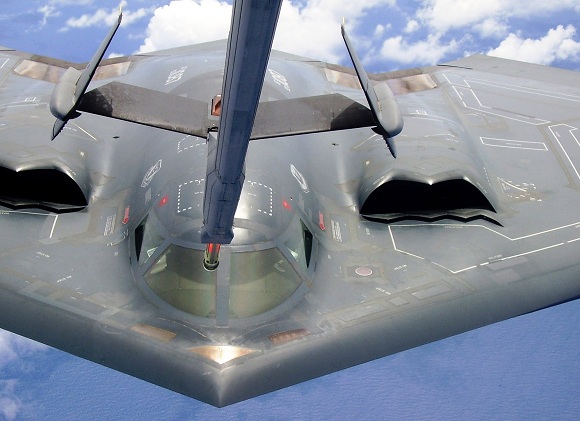
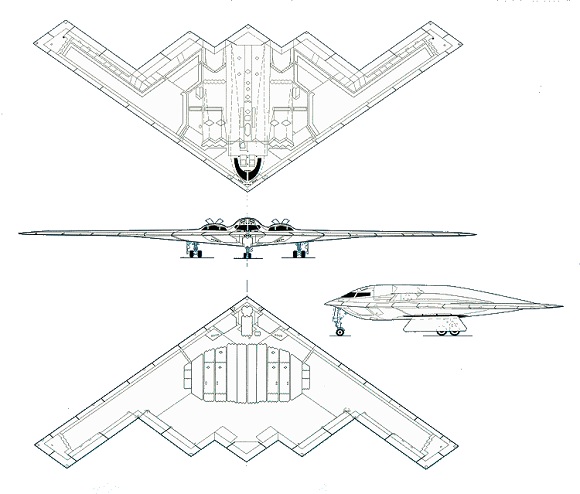
Illustration of internal S-ducting to hide turbine faces.

Federation of American Scientists B-2 Spirit
Note the entire aircraft is all serrated edges and curves, no long straight lines, 90 degree connections etc. unlike the huge RCS of the B-52
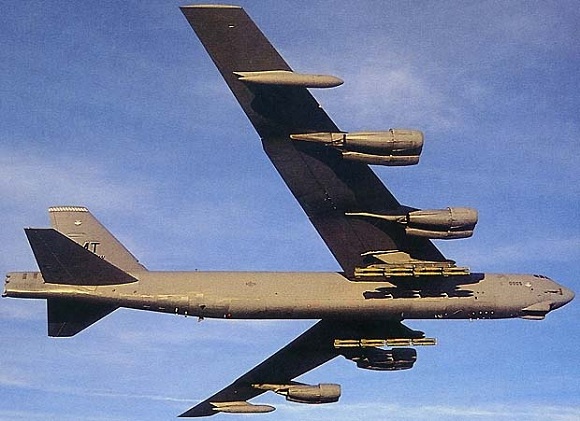
In this case, I would guess that the most sensitive technology would be the sensor package carried by the RQ-170 although it could easily be no more than a basic side scan radar or digital camera with a military wi-fi link. (Sarcasm)
A major concern for the U.S. government is that the Iranians might be able salvage highly sensitive technology, such as cameras or sensors, from the RQ-170, or even stealth features, and try to copy it for their own systems.
Defense Systems/ RQ-170 crash might put US sensor technology at risk
From the low quality images of the Beast that exist aviation experts argue stealth to be moderate, the side views of the aircraft show the belly fairing which looks like it houses an electro-optical/infrared sensor at the front.
Some experts are also on the opinion that a side looking AESA (Airborne Electronically Scanned Array) radar could be housed behind it, in the belly supporting all-weather, high resolution radar-imaging by Synthetic Aperture Radar processing.
There’s still a mystery of the over-wing fairing about what is hidden beneath. Experts like Bill Sweetman of Aviation Week said ““One possibility: they contain antennas that can be rotated, when not in use, to reduce their reflectivity, given that the best bandwidth-selective radome (radar dome) can only do so much.
So if your UAV is being illuminated by radar, you turn to place that radar on one side of the aircraft and use the antenna on the opposite, “shadow” side of the aircraft to communicate.”
Defense Aviation
What is new about the RQ-170 is that it is the first generation of UAV to combine some stealth into an affordable, easily maintainable planform. The design is intended to be built in large numbers to help ease the current high demand for drone time and to easily replace losses whether through mundane attrition or combat.
Follow the landing of a damaged Navy EP-3E in China, in early 2001 Defense Secretary Donald Rumsfeld called a classified, all-day session of those with responsibilities for “Sensitive Reconnaissance Operations.” (AW&ST, June 4, 2001, p. 30)
They discussed how to avoid future embarrassing and damaging losses of classified equipment, documents or aircrews without losing the ability to monitor the military forces and capabilities of important countries like China.
Their leading option was to start a new, stealthy, unmanned reconnaissance program that would field 12-24 aircraft. Air Combat Command, then led by Gen. John Jumper, wanted a very low-observable, high-altitude UAV that could penetrate air defense, fly 1,000 nau. mi. to a target, loiter for 8 hr. and return to base.
Aviationweek/ RQ-170 Has Links to Intelligence Loss to China
Technically, the RQ designation denotes an unarmed aircraft rather than the MQ prefix applied to the armed Predator and Reaper UAVs. The USAF phrase, "Support to forward deployed combat forces," when combined with observed details, suggest a moderate degree of stealth (including a blunt leading edge, simple nozzle and overwing sensor pods) and that the Sentinel is a tactical, operations-oriented platform and not a strategic intelligence-gathering design.
Aviationweek/ USAF Confirms Stealthy UAV Operations
Iran is a big country with a finite aerial surveillance radar capability. Stealthy just means harder to see, not invisible. Hypothetically, if the RQ-170 degraded search radar performance by only 50%, it opens up a lot of holes for a surveillance platform to get inside of a radar picket undetected. The lower RCS even modestly degrading detection range combined with a high sub-sonic speed would make the drone nearly immune to interception, as long as you stay out of the detection range of the more savvy and powerful fixed ground to air tracking and targeting radars.
An more sophisticated airframe is simply unnecessary for the role at hand.
In the post WWII east/west difference of quality vs. quantity , lesser numbers of higher quality technology seem to have consistently proven the superior design philosophy time and again. The caveat being you cant be scared to scratch your new toy when push comes to shove and that hesitation has popped up more than once that I know of...
A few prime examples being the hesitation to deploy strategic assets such as the B-2 into combat operations in the late 90's Serbian mess, the hesitation by the NRO and CIA to use the SR-71/A-12 to directly overfly Soviet territory to gain nuclear targeting data, SAC hesitation to deploy the nuclear strike modified B-52G's to supplement the in theater B-52D's during Linebacker II etc..
In the end the realizations that every weapons system needs to be blooded to be proven, the investment being worthless if you do not exploit it, has usually won out over other fears and the system has been used.
While there are undoubtedly exotic prototypes of amazing technologies under various stages of development such as the X-51 WaveRider

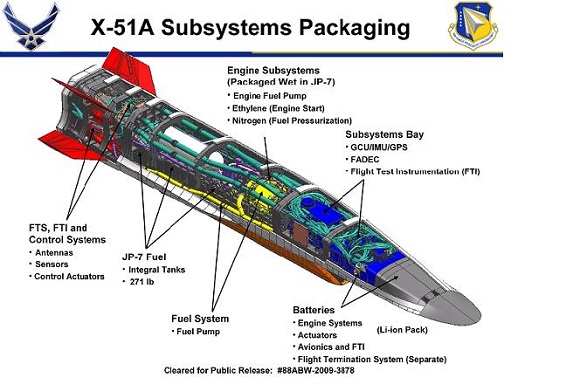
Aviation Society/Air Force’s second hypersonic Waverider
and X-43 Hyper-X programs..
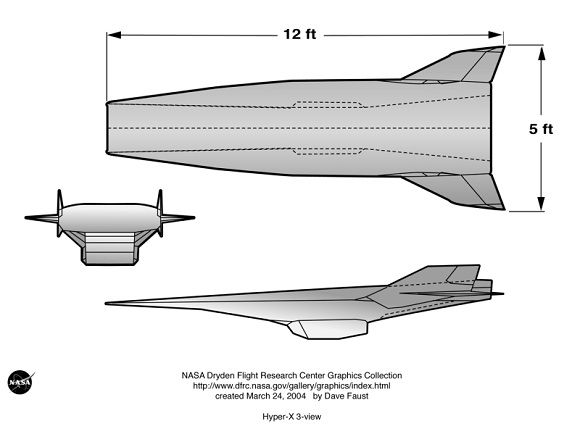
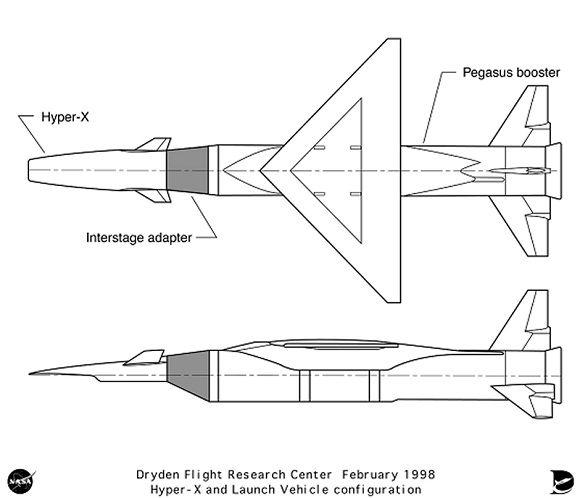
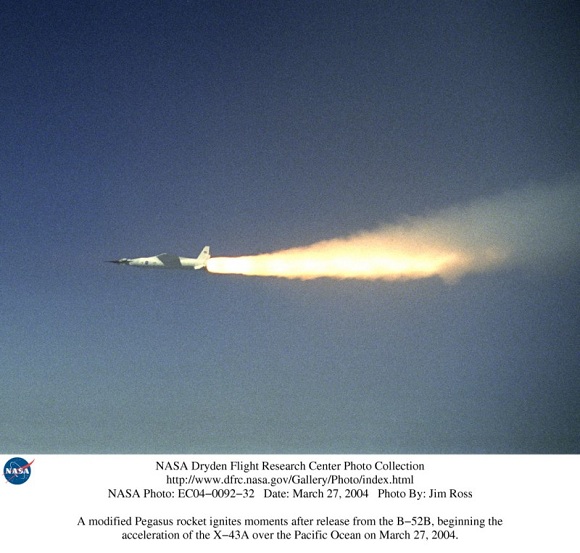
Global Security/ X-43B
The battlefield of the future is clearly robotic. The thrust of most known R&D shows a strong emphasis on replacing flesh and blood with machines in many conventional roles. Sensor integration with better communications for improved information distribution aimed at increasing situational awareness are the next big game changers.
What drone is being operated at a higher technological level by the US military/CIA?
If I understand your question correctly, definitely the X-37B
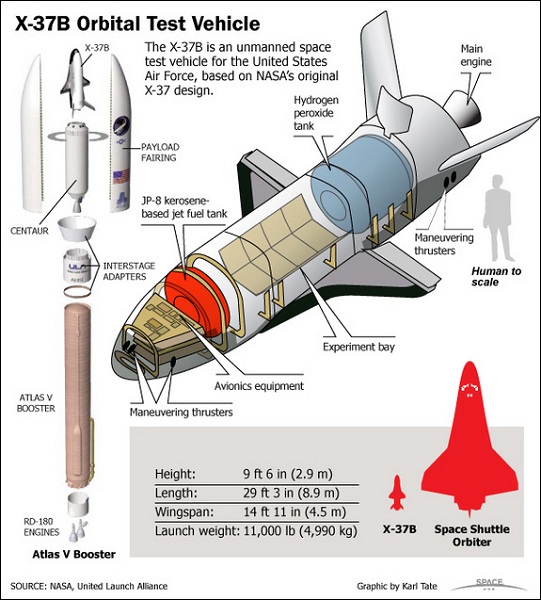


Space Fellowship/X-37B Orbital Test Vehicle Successfully Completes 1st Flight
Space.com/ X-37B Space Plane
and X-47B Pegasus drone programs.

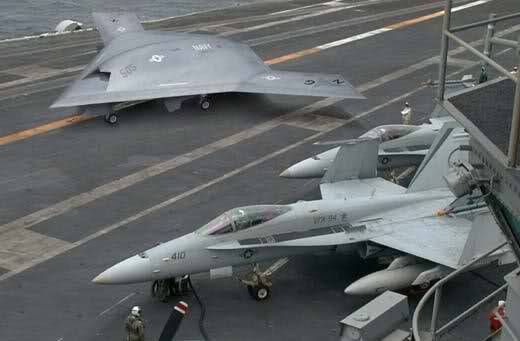
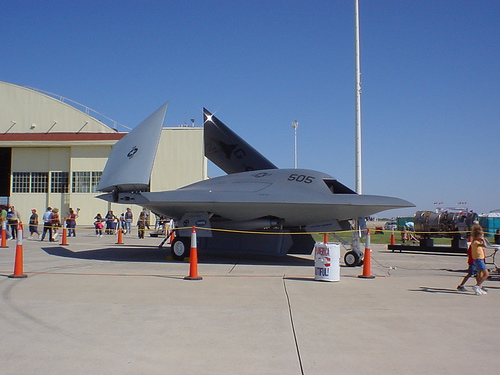
The Breitling Watch Source Forums/ A treat for you Airplane junkies
Flight Global/ Northrop Grumman wins US Navy unmanned bomber contract
What is possibly more closely guarded than the RQ-170?
Lots... Nothing.... Anybody that knows certainly wont be saying here....
There has been a lot of rumored high altitude long endurance research intended to supplement communications, GPS etc. in a future conflict against an ASAT capable foe.

Aviationweek/ Boeing Phantom Eye Preps For Ground
Boeing has unveiled its unmanned hydrogen-powered spy plane which can fly non-stop for up to four days.

DARPA’s Vulture program is developing an unmanned aircraft capable of remaining on-station uninterrupted for over five years. Boeing September 14th 2010 signed an agreement with the U.S. Defense Advanced Research Projects Agency (DARPA) to develop and fly the SolarEagle unmanned aircraft for the Vulture II demonstration program. Under the terms of the $89 million contract, SolarEagle will make its first demonstration flight in 2014.
Defence AviationBoeing to develop SolarEagle UAV for DARPA Vulture II program
There has been quite a bit of open talk about stealth blimps, military applications for lighter than air technology etc. and such up in the last few years. Although most public discussion has ceased, the government funding has continued and grown.
Based on the evidence publicly available, the U.S. is fastracking multiple advanced high altitude, long endurance, low observable programs that are receiving almost no attention at all.
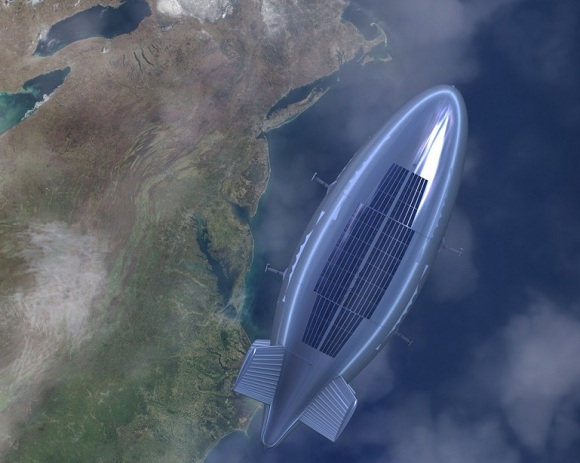
May 1, 2009 The idea of replacing very expensive space based satellites and Aircraft mounted Airborne Warning And Control Systems (AWACS) with stationary platforms inside Earth's atmosphere has been floated for decades. Despite the fact that lighter-than-air vehicles or airships that could fulfill this role have been flying for over 300 years, the idea is only now getting off the ground. U.S. Defense contractor Lockheed Martin has been chosen by the Defense Advanced Research Projects Agency (DARPA) for a US$400 million contract to to design, build, test and fly a 1:3 scale model of an airship surveillance and telecommunications platform called the High Altitude Airship (HAA).
Lockheed Martin to develop geostationary Solar Powered Airship
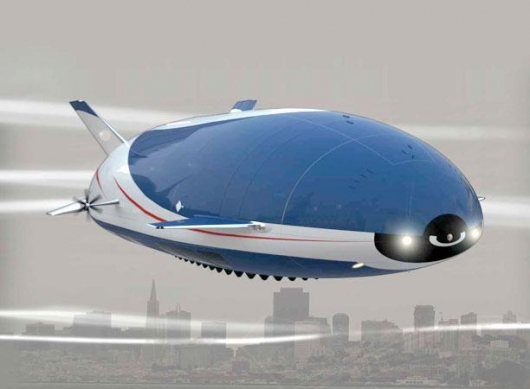
November 2, 2007 An integral part of the exciting ML866 "superyacht for the sky", Aeros’ Control of Static Heaviness (COSH) system allows airships to adjust their weight in mid-flight without the use of a traditional ballast material. After successful initial tests of the controversial system, Aeros has been awarded funding by the Defense Advanced Research Projects Agency (DARPA) for further demonstrations.
DARPA provides funding for Aeros' ballast-free airship weight control system
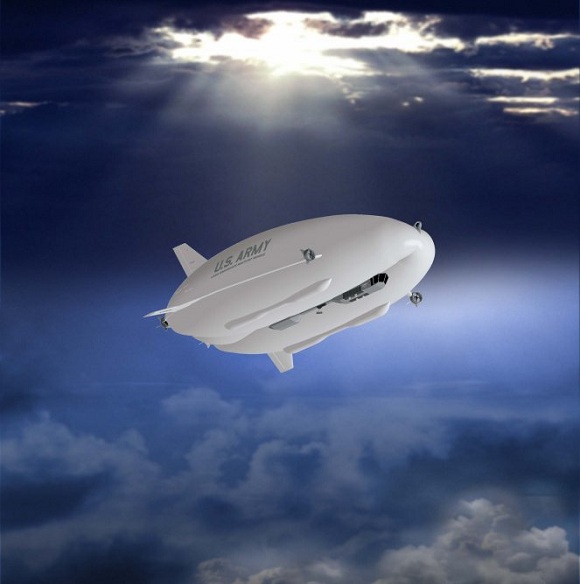
Northrop Grumman has been awarded a US$517 million contract to develop the massive airship and present it for military assessment in just 18 months. The company is developing the LEMV to plug straight into the the Army's existing ground command centers and will provide flight and ground control operations. According to the company release, the LEMV will "operate within national and international airspace" from "austere operating locations using beyond-line-of-sight command and control."
Long Endurance Multi-Intelligence Vehicle (LEMV)
That's where I would look, not towards the RQ-170....
edit on 9-12-2011 by Drunkenparrot because: Sp
Originally posted by Marrr
reply to post by Dimitri Dzengalshlevi
Ok, I was incorrect there. The topic at that time was an unmanned spy platform in the U.S. arsenal that was referred to as a smart drone and triangular in shape, distinctly different than the captured drone in question.
When speaking of a generation old. That is my opinion of the stealth capabilities of the drone. To me, it's reminiscent of F117 or B-2 technology.
Invincible?edit on 9-12-2011 by Marrr because: (no reason given)
I am not familiar with any official aircraft that is "triangular" in shape.
In terms of US drones, the Sentinel and X-47 both look similiar and have similar functions (and they are designed as "split diamonds"/"flying wings", not triangular). There aren't any other radically different drones deployed by the US, unless you count older generation Predators and Global Hawks which aren't stealth designed.
The Nighthawk is a generation behind the B2. Personally, I don't even know how the Nighthawk could even fly just by looking at it but it managed. The Sentinel is shaped like the B2, and incorporates radar-absorbing materials like the B2, but clearly it is much smaller. Its size makes it capable for more tactical jobs than the B2, which really only serves a role for bombing things. The Sentinel is not of the same generation as the B2 (deployment is like, 20 years apart).
The reason why the US isn't fielding anything newer than B2 technology is because it works for what they are doing- which is mostly scouting and bombing enemies that don't even have an airforce or capable anti-air weapons to defend themselves with.
but if you're talking about flying triangles, then maybe you're getting into unofficial hardware. Any discussion on this is, for the most part, speculation. Is there a TR3? Probably. I know people even around where I come from who have seen it at night in remote locations. I'm sure that the US isn't the only country with secret military hardware and likewise projects. I'm also certain that just because such hardware exists, doesn't mean that it has anything to do with official events, even if such secret hardware was actually involved (get my drift?)
EDIT:
Drunkenparrot-
In the modern age where many new systems spend 10,15, even 20+ years in gestation "New/old technology" is semantics. It could be argued that by the time any system is revealed to the public or mature enough to be deployed into a real world scenario it is "old technology".
*sigh*
Again, for the upteenth time...
You can have technology 500 years into the future. It means absolutely jack if it isn't being fielded. And if it is fielded, than you can bet that your competent rivals are already building counterparts, or already have something beyond what you have.
The whole argument that "well, what we field is old technology because what we are working on is 20 years in the future" is a joke to me, because by the time you deploy it for serious deployment, it'll already be 20 years in the future. Just look at the F-22; when did it start development, the late 80s? And it is still undergoing modernization upgrades?
EDIT2:
What drone is being operated at a higher technological level by the US military/CIA?
If I understand your question correctly, definitely the X-37B
My question was deployment, not "operated". The X-37B is being tested, though that isn't to say that it isn't operational at the same time. However, the X-37B does not nearly have the same role as the Sentinel. Sending some kind of unmanned craft into space is not the same as deploying a stealth UAV to carry out recon.
Your post was good though, for what it's worth.
edit on 9-12-2011 by Dimitri Dzengalshlevi because: (no reason given)
reply to post by THE_PROFESSIONAL
actually seal team 6 may have been blown up by forces in the u.s. intelligence who didnt want what the seals knew about the bin laden raid to get out. the fact that bin laden most likely wasn't even there and it was a farce, or possibly something else. they were saying it was very odd that they were taking a coast guard chopper instead of their usual helicopter, and some insider seals from teams 1 and some other team that knew some members from team six suspected foul play. went over it in detail on the alex jones show.
actually seal team 6 may have been blown up by forces in the u.s. intelligence who didnt want what the seals knew about the bin laden raid to get out. the fact that bin laden most likely wasn't even there and it was a farce, or possibly something else. they were saying it was very odd that they were taking a coast guard chopper instead of their usual helicopter, and some insider seals from teams 1 and some other team that knew some members from team six suspected foul play. went over it in detail on the alex jones show.
reply to post by ADVISOR
I HIGHLY doubt they "hacked" the drone. I'm confident enough to say it would be impossible to do. As I wrote in my first post on this topic, you can NOT just spoof a signal.
You have to create an authenticated connection to the drone, and you have to complete an encrypted "handshake" with every command you send to the drone, and you have to do it within an existing sequence.
Cracking the encryption alone would take a super computer many days. You would also have to reverse engineer the challenge-response protocol, and figure out the command and response structure.
This is not your typical RC toy that communicates with simple radio pulses which can malfunction if your friend's RC toy operates on the same frequency. It's more like a computer connecting to a server with a highly secure communication protocol. The server (the drone) would ignore all commands and signals that can't be authenticated, and the commands wouldn't even work unless it follows a strict structure.
If they had spies and somehow got access to all the encryption algorithms, and they had a detailed explanation of the communication protocol including all the available commands, only then could they even fathom having a chance at getting a connection to the drone while it is already in flight, let alone actually fly it.
I highly doubt they "jammed" it too. It would be stupid to build those slightly autonomous aircraft without a navigation fall back and dependent on external signals. Meaning, if GPS satellites suddenly became unavailable the drone would be able to rely on the magnetic field of Earth to gauge the heading, and it would store the time and the speed it has been flying in memory in order to calculate where it took off from, and where it is, and compensate for the rotation of Earth, and other environment factors such as wind. Basically, if you closed your eyes and walked around, and you memorized each step you made, you could back track your steps and know how to return to where you started without using any external information such as GPS satellites.
I am sticking with my theory that the engine failed and the drone tried to glide and land. Normally in that case it would be recovered, but it's behind enemy lines and it looks like Iran got a hold of it first.
I HIGHLY doubt they "hacked" the drone. I'm confident enough to say it would be impossible to do. As I wrote in my first post on this topic, you can NOT just spoof a signal.
You have to create an authenticated connection to the drone, and you have to complete an encrypted "handshake" with every command you send to the drone, and you have to do it within an existing sequence.
Cracking the encryption alone would take a super computer many days. You would also have to reverse engineer the challenge-response protocol, and figure out the command and response structure.
This is not your typical RC toy that communicates with simple radio pulses which can malfunction if your friend's RC toy operates on the same frequency. It's more like a computer connecting to a server with a highly secure communication protocol. The server (the drone) would ignore all commands and signals that can't be authenticated, and the commands wouldn't even work unless it follows a strict structure.
If they had spies and somehow got access to all the encryption algorithms, and they had a detailed explanation of the communication protocol including all the available commands, only then could they even fathom having a chance at getting a connection to the drone while it is already in flight, let alone actually fly it.
I highly doubt they "jammed" it too. It would be stupid to build those slightly autonomous aircraft without a navigation fall back and dependent on external signals. Meaning, if GPS satellites suddenly became unavailable the drone would be able to rely on the magnetic field of Earth to gauge the heading, and it would store the time and the speed it has been flying in memory in order to calculate where it took off from, and where it is, and compensate for the rotation of Earth, and other environment factors such as wind. Basically, if you closed your eyes and walked around, and you memorized each step you made, you could back track your steps and know how to return to where you started without using any external information such as GPS satellites.
I am sticking with my theory that the engine failed and the drone tried to glide and land. Normally in that case it would be recovered, but it's behind enemy lines and it looks like Iran got a hold of it first.
Originally posted by dplum517
reply to post by TheOdogg
Is it just me or are they not giving a link or sharing the video?
.....This is precisely the reason we have drones. No loss of human life.
You would think they would put a self destruct mechanism in those thingsedit on 8-12-2011 by dplum517 because: (no reason given)
They took it down using an EMP burst. No time to even use a self destruct button. They would have had to be aware, that the EMP was coming first.
reply to post by Drunkenparrot
Most of these photos are probably stealth planes because they are just horrid to look at.
Most of these photos are probably stealth planes because they are just horrid to look at.
reply to post by tEkAshr
Duh Duhhhhhh. This is an obvious that many people ignore. Its obvious that a good 99% of sightings will be that of government created crafts. This just goes to show what kind of weird and wonderful crafts they have out there in our skys.Who's to say they dont have working saucer shaped disks flying around our skys at super speeds and then oh, pictures roll in, what is it? - Government - extraterrestrial UFO's do not exist but we cant tell you what it really is - its our creations really.
Duh Duhhhhhh. This is an obvious that many people ignore. Its obvious that a good 99% of sightings will be that of government created crafts. This just goes to show what kind of weird and wonderful crafts they have out there in our skys.Who's to say they dont have working saucer shaped disks flying around our skys at super speeds and then oh, pictures roll in, what is it? - Government - extraterrestrial UFO's do not exist but we cant tell you what it really is - its our creations really.
Originally posted by K1771gnorance
This is not your typical RC toy that communicates with simple radio pulses which can malfunction if your friend's RC toy operates on the same frequency.
You're right, it's not an RC toy; it's a military drone. The Iranian electronic warfare division isn't tasked with hacking RC toys either.
The simple fact that Iran has its own drone fleet shows that the Iranian military knows something about drones and how communication works between craft and operator. Iran has also shot down and recovered other US/Israeli drones before, some of these drones being unconventional. They aren't exactly inexperienced in this field.
Here's an interesting article that you may like: Meet The Russian Avtobaza — Iran's Possible Drone Killer
edit on 9-12-2011 by Dimitri Dzengalshlevi because: (no reason given)
reply to post by K1771gnorance
there's been stories before about enemies intercepting drone video transmissions with the knowledge supposedly coming from Iran. perrya.hubpages.com...
actually taking control seems unlikely but you never know. They may have managed to disable the drone electronically in some way causing it to land.
there's been stories before about enemies intercepting drone video transmissions with the knowledge supposedly coming from Iran. perrya.hubpages.com...
actually taking control seems unlikely but you never know. They may have managed to disable the drone electronically in some way causing it to land.
Originally posted by Dimitri Dzengalshlevi
Originally posted by Ben81
I dont see any damage ... how in hell did they capture it ?
Someone say it was hacked .. that would explain why it is intact
It's already been explained many times since the story broke... but the truth easily gets lost and ignored when there are pages of baseless accusations and assumptions.
- US sources originally claimed that they lost all communications with the craft over Iranian airspace.
- US sources said that in the event of simply losing communication with the craft, that it is programmed to return to base. However, the sources that I saw also said that if this programming was compromised (in other words, a system malfunction), then the shape and design of the drone was to allow it to glide to the ground to avoid serious damage such as would be the case in typical manned jets.
- Iranian sources have claimed from the start that their electronic warfare division "took down" the craft, and then recovered it on the ground. This makes sense considering that the US said they lost communication with the craft and it did not automatically RTB.
So it makes sense (to me, anyways) that some kind of electronic countermeasure, probably a signal jammer, was used to disable the Sentinel. I doubt that some Iranians on computers hacked into the craft's systems as some of the sensationalist claims imply.
Here is one of the prevailing rumors that may have a hint of truth?...
Could this be the smoking electron in the alleged unmanned air vehicle (UAV) incident over Iran? The original reports that Iran "shot down" a Lockheed Martin RQ-170 Sentinel appear to be misleading. Iranian news agency reports credited the army's electronic warfare unit with bringing down the UAV, but apparently in a way that limited the amount of damage on landing or impact.
Only six weeks ago, Russia announced delivering the Avtobaza ground-based electronic intelligence and jamming system (shown above) to Iran. Most Russian weapons exports to Iran are blocked, including the proposed transfer of the S-300 surface to air missile system. But there is a key difference between a SAM battery and a jamming system. The S-300 can vastly complicate a strike on an Iranian nuclear site at Natanz or Qoms. A jamming system, such as the Avtobaza, is unlikely to be used to defend such a site because it could interfere with the radar of the S-300 or the Tor-M1 SAM battery.
The Avtobaza, moreover, is designed to jam side-looking and fire control radars on aircraft and manipulate the guidance and control systems of incoming enemy missiles. It would be the perfect tool to target and perhaps infiltrate the communications link that allows a UAV to be controlled from a remote location.
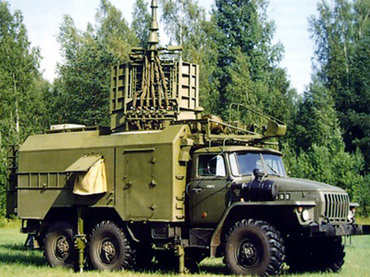
Avtobaza: Iran's weapon in alleged RQ-170 affair?
reply to post by Drunkenparrot
I just added a link to the Avtobaza in my last post. Interesting coincidence
I just added a link to the Avtobaza in my last post. Interesting coincidence
Originally posted by Dimitri Dzengalshlevi
You're right, it's not an RC toy; it's a military drone. The Iranian electronic warfare division isn't tasked with hacking RC toys either.
The simple fact that Iran has its own drone fleet shows that the Iranian military knows something about drones and how communication works between craft and operator. Iran has also shot down and recovered other US/Israeli drones before, some of these drones being unconventional. They aren't exactly inexperienced in this field.
Here's an interesting article that you may like: Meet The Russian Avtobaza — Iran's Possible Drone Killer
Let me put it this way... I can write and design a client and server that utilizes a challenge-response authentication protocol and, even if I gave you the source code, and you magically studied the communication between the client and server, you nor anyone would EVER be able to "middle-man" hack and crack the communication between an ongoing connection, and spoof communications with the server. It would be literally be IMPOSSIBLE.
Originally posted by K1771gnorance
Let me put it this way... I can write and design a client and server that utilizes a challenge-response authentication protocol and, even if I gave you the source code, and you magically studied the communication between the client and server, you nor anyone would EVER be able to "middle-man" hack and crack the communication between an ongoing connection, and spoof communications with the server. It would be literally be IMPOSSIBLE.
You're thinking way to technical. you also seem to be assuming that Iran hacked the drone.
It's more believable that Iran disabled the signal somehow- doing so would be easier than hacking into the drone. The technology is available to do this. There have even been instances in the past where American drones on missions have lost contact with their operators and have subsequently crashed (or shot down by an American fighter as a precaution, in one case).
The fact that Iran has confiscated downed American drones in the past shows that they've had the opportunity to analyze the equipment to get some idea of how to deal with it. Add to this Iran's intelligence capability which, considering the long arm of the IRG, probably has the ability to update the military with information concerning updates to American drone control. Then there's the fact that countries like Russia are allowed to, and actually are arming Iran with electronic warfare hardware designed to counter drones.
Originally posted by Dimitri Dzengalshlevi
What drone is being operated at a higher technological level by the US military/CIA?
If I understand your question correctly, definitely the X-37B
My question was deployment, not "operated". The X-37B is being tested, though that isn't to say that it isn't operational at the same time. However, the X-37B does not nearly have the same role as the Sentinel. Sending some kind of unmanned craft into space is not the same as deploying a stealth UAV to carry out recon.
Your post was good though, for what it's worth.edit on 9-12-2011 by Dimitri Dzengalshlevi because: (no reason given)
I think that he meant the X-47b.
new topics
-
Biden’s DOJ pays off FBI operatives.
US Political Madness: 7 minutes ago -
Understanding the likelihood of simulation theory by referring to AI and highly cogent dream states
Philosophy and Metaphysics: 4 hours ago -
Interesting - anti-Christian bias task force proposed
2024 Elections: 5 hours ago -
Mastering 'the art of brainwashing,' China intensifies AI censorship
Other Current Events: 5 hours ago -
Hilarious spoof ad mocks Kamala Harris
Jokes, Puns, & Pranks: 6 hours ago -
"March for the Freedom for Britain" - Trafalgar Square London - Live
Regional Politics: 7 hours ago -
In four years, you don’t have to vote again.
2024 Elections: 9 hours ago
top topics
-
Hilarious spoof ad mocks Kamala Harris
Jokes, Puns, & Pranks: 6 hours ago, 25 flags -
In four years, you don’t have to vote again.
2024 Elections: 9 hours ago, 12 flags -
Interesting - anti-Christian bias task force proposed
2024 Elections: 5 hours ago, 9 flags -
I've realized something about Politics recently.
US Political Madness: 13 hours ago, 7 flags -
France bans head coverings but allows Christianity to be mocked at Olympics.
Political Conspiracies: 15 hours ago, 6 flags -
"March for the Freedom for Britain" - Trafalgar Square London - Live
Regional Politics: 7 hours ago, 5 flags -
Understanding the likelihood of simulation theory by referring to AI and highly cogent dream states
Philosophy and Metaphysics: 4 hours ago, 3 flags -
Mastering 'the art of brainwashing,' China intensifies AI censorship
Other Current Events: 5 hours ago, 3 flags -
Woo time it aint over yet
Paranormal Studies: 16 hours ago, 3 flags -
Biden’s DOJ pays off FBI operatives.
US Political Madness: 7 minutes ago, 2 flags
active topics
-
France bans head coverings but allows Christianity to be mocked at Olympics.
Political Conspiracies • 53 • : Zanti Misfit -
Did Russia just attack a NATO nation?
The Gray Area • 57 • : andy06shake -
Biden’s DOJ pays off FBI operatives.
US Political Madness • 0 • : Dandandat3 -
Hilarious spoof ad mocks Kamala Harris
Jokes, Puns, & Pranks • 23 • : Athetos -
Obamas endorse Kamala
2024 Elections • 38 • : 777Vader -
In four years, you don’t have to vote again.
2024 Elections • 135 • : wAnchorofCarp -
Olympics France 2024 Opening Ceremony
World Sports • 15 • : putnam6 -
Newsweek states Trump was not shot - cites FBI Director Wray
US Political Madness • 121 • : Zanti Misfit -
Fasten your seatbelts!
2024 Elections • 60 • : WeMustCare -
"March for the Freedom for Britain" - Trafalgar Square London - Live
Regional Politics • 7 • : gortex

